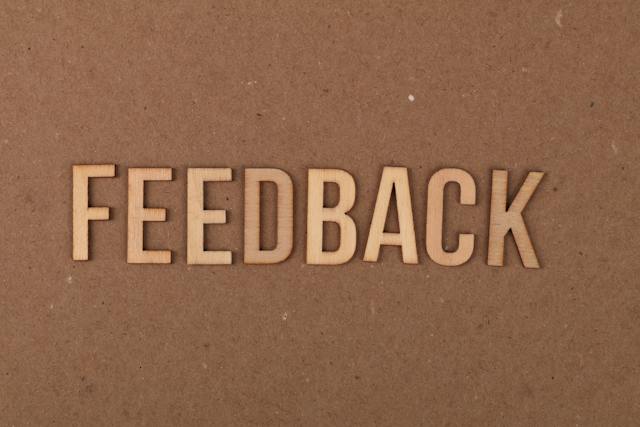Giving and receiving feedback is something of an art form, if it is used correctly and constructively though, feedback can be hugely powerful.
Feedback can take numerous forms and an article on the Leaders website describes 7 types of feedback that typically occur in the workplace and can be used interchangeably depending on the circumstances and what works best for each individual. The 7 types are:
- Appreciation feedback
- Guidance feedback
- Encouragement feedback
- Forward feedback
- Coaching feedback
- Informal feedback
- Formal feedback
Any of these types of feedback are a two way process with one person giving and the other person receiving the feedback, and it is important therefore to understand those two parts and how they work.
Giving feedback
Feedback is basically a form of guidance and in a working environment it is primarily given with the aim being that it results in reinforcement or improvements of behaviours. When giving feedback you need to understand the purpose of the conversation that you are about to have and it is important to be prepared. Having a structured approach to the delivery of your feedback is a great way to do this and to ensure that you get the message across effectively. A commonly used approach to feedback is what is known as the Situation-Behaviour-Impact model. This model was developed by the Centre For Creative Leadership and works as follows:
“Situation: you outline the situation you’re referring to, so that the context is clear and specific.
Behaviour: you discuss the precise behaviour that you want to address.
Impact: finally, you highlight the impact of the person’s behaviour on you, the team and the organisation”.
This model really works and can be used for both negative and positive circumstances. If the feedback that is being given relates to poor behaviour then this model uses clear examples of issues that need to be addressed and doesn’t skirt around problems. By the same token if the feedback being given is about positive behaviour, then the employee can understand exactly what they have done well so that they then know what to do again in a similar situation. A very basic example of this is to not just say, “well done”, and leave feedback at that, but instead to add the context and say, “well done on how you handled that customer complaint and kept them fully informed of what you were doing to resolve their problem”. There is a clear difference between the two. In addition, by having a focus on behaviour this can help when feedback is negative as it depersonalises the issue to some extent and focuses on the behaviour and not the employee themselves. Considering the impact of behaviour, again either positive or negative, is vital to giving effective feedback. Let the person you are giving feedback to know how what they said or did made you feel or what the effect on other people was. When giving feedback you needed to think about timing. Don’t give feedback when emotions and feelings may be running high as this could lead to problems due to the person receiving feedback not being receptive and able to process it constructively no matter how well it is delivered. That said feedback should be delivered in a timely manner so that the situation which is being discussed is fresh in the mind and also make sure to ask questions so that you get a fuller picture by encouraging the recipient to tell you their side of things.
Receiving feedback
Learning and understanding how to behave and react when receiving feedback is equally as important as knowing how to effectively give feedback. Receiving feedback is actually a skill and if you have that skill then you can use feedback in a powerful manner so that is constructive and allows you to grow and develop. You may have regular meetings with your manager or colleagues and receive feedback at those meetings, if you don’t then requesting feedback is a great place to start as it shows that you are open to take advice and guidance onboard. There may also be other opportunities to receive feedback such as after the completion of a project, presentation or even an interview so don’t be afraid to ask for it. Your reaction to feedback is significant. If you react badly when receiving feedback then that may put people off from giving it to you in future. If you react positively then it will encourage further feedback opportunities and open up more conversations. A positive reaction also shows a maturity and a willingness to learn and improve. Don’t be defensive here, if you have made a mistake then own it and acknowledge what you can do differently next time. The feedback recipient can get the most out of a feedback discussion by listening, taking time to process what is said and asking relevant questions. Listening may sound obvious but sometimes you really need to listen to understand what is being said. Giving yourself time and permission to reflect on what has been said is also helpful. By processing the discussion in this manner you can achieve a deeper understanding and that then often leads on to the final part of asking questions to qualify, clarify and if necessary gain further insight. Finally, if someone has taken the time and made the effort to provide feedback and to try and help you to improve then they are worthy of your gratitude. Say thank you, talk about the next steps you are going to take and make sure that you follow through on these actions.
If you want help with anything to do with giving and receiving feedback then get in touch with the CUBE HR team.
Do you have any questions about todays blog, need help in becoming legally compliant with contracts/policies or can we support you in taking away any people pains to give you peace of mind?
If you answered yes to any of the above, just give us a call at CUBE HR on 01282 678321, or book in a FREE 30 Minute HR Health Check here FREE HR Health Check and we’ll happily give your business a full HR overview with our personal recommendations absolutely FREE!
Why not also check out our blog on a similar topic 360 degree feedback
We also have a YouTube channel with loads of handy videos outlining various HR related scenarios.




